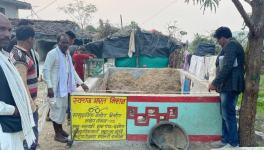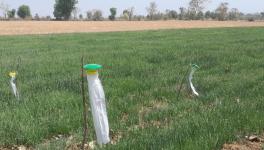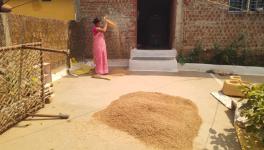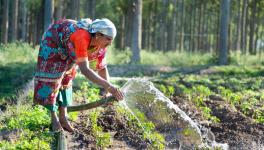La La Lantana: MP Villagers Clear Out Invasive Plant Species, Laugh All the Way to the Bank
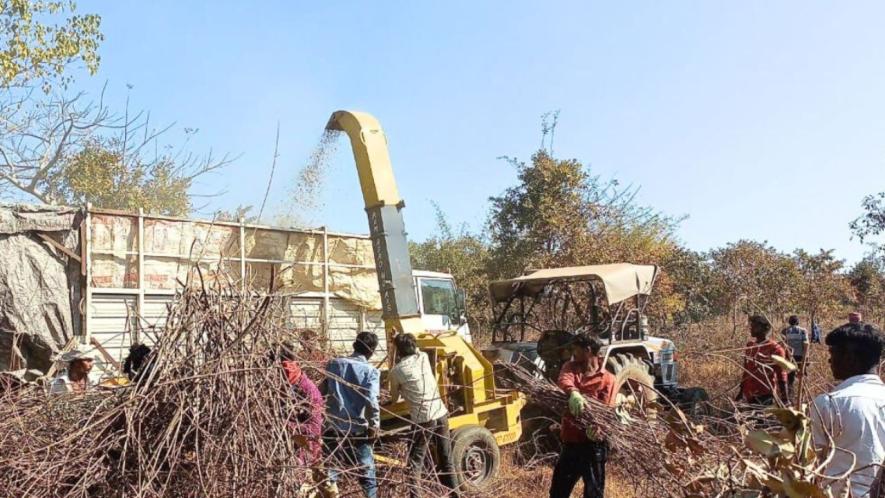
Breaking down lantana with a machine (Photo - Sanavver Shafi, 101Reporters)
Bhopal, Madhya Pradesh: “I still remember collecting chironji from Majhgawan forest range, so that my family could meet the expenses related to my sister’s wedding feast. It was two decades ago. My mother, two brothers and I spent four days in the forest collecting 80 kg of chironji. I sold it in the market and arranged money for the feast. Today, the situation has changed. No matter how many days you spend in the forest, you will get nothing.”
Rameshwar Mawasi (75), a Mawasi tribal from Chitahra village in Majhgawan block of Madhya Pradesh’s Satna district, is a witness to the slow death of the local forest due to the invasion of lantana (Lantana camara). “With the forest department fencing large tracts, we have access only to a few areas where only mahua, chironji and some herbs grow. Sadly, they are on the verge of destruction due to the invasive species,” he adds.
Lantana first came to India from Latin America as an ornamental plant in the 1800s, but later spread across the country. According to Bhopal Divisional Forest Officer (DFO) Alok Pathak, conservation of native species is important in view of climate change. However, lantana restricts the diversity of many indigenous species and herbs. It absorbs water and nutrients faster than other forest species and affects soil fertility. It can also adversely affect the health of grazing animals due to the toxic compound found mostly in its leaves. Its dense thickets increase the risk of forest fires as well.
A research article published in Global Ecology and Conservation in 2020 assessed the lantana spread in the country's forests. The team members surveyed 2,07,100 sq km of forests and found that lantana has invaded 1,54,837 sq km of the surveyed forests. Through this sample, they assessed that 303,607 sq km of the total forest area in the country is threatened by lantana invasion.
Due to lantana invasion, tribals face shortage of their traditional foods and are forced to migrate for employment. The new generation of tribals are losing traditional knowledge about forest produce that have gradually disappeared. “Until a few decades ago, the people of our community were skilled in finding fruits, vegetables and even medicinal plants from the forests, but not anymore,” notes Rameshwar.
A project takes shape
The forest department makes efforts to clear out lantana every year, with the work done before the rains (April-May) and again after the rains (August-September). However, the 2021 effort was particularly striking as the department started sending shredded lantana chips to a cement plant in Satna district, to be used as a combustible fuel substituting coal.
The Village Forest Committee (VFC), in which all residents of that particular village are members, was assigned the task of uprooting lantana bushes from the forest area. The VFC members who participated in the effort received Rs 1,200 per metric tonne of shredded lantana chips in their bank accounts, while the committee’s dividend was Rs 500 per metric tonne.
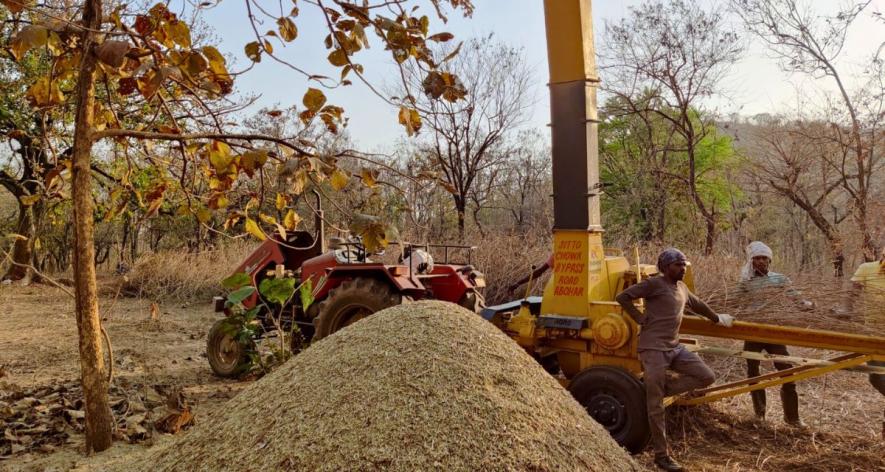
Clearing out lantana in Rampur Patha (Photo - Sanavver Shafi, 101Reporters).
“Collective efforts and regular monitoring can tackle even poisonous and invasive species like lantana,” Satna DFO Vipin Kumar Patel tells 101Reporters. “The work provides economic, social and environmental benefits to the community. People get paid for weed removal, while VFC receives dividends that can ensure development of the area,” he adds.
Rewa DFO Anupam Sharma, who has been instrumental in creating and running the project, tells 101Reporters that the idea crossed his mind when he was attending a meeting with senior officers regarding lantana eradication, while posted in Satna division as a trainee officer in 2021. “Examining several researches made me realise that lantana can be used as biomass. Subsequently, my colleagues and I made a list of cement plants in the district. We learnt that most of them were using bioenergy [wood, wood residues, crop residues or household waste] as an alternative to coal.”
The team then held discussions with a few cement plant operators, but they wanted to ascertain the calorific value of lantana (the amount of energy released when it is burnt). “With the help of the plant operators, we got the calorific value of lantana tested by a Bengaluru company. This report revealed that the calorific value of coal was 4,800 kcal/kg, while the grass calorific value of lantana was 4,200 kcal/kg and the net calorific value 3,900 kcal/kg, which made it a better alternative to coal as green fuel in cement plants. After the report came, a cement plant said they were ready to accept shredded lantana bushes,” Sharma details.
After discussions with top officials, a proposal was sent to the government for approval. “On getting approval, we started work on the pilot project in Patehra VFC in Maihar forest range of Satna in 2021. We ordered the JF40 chaff cutter machine from a company in Bengaluru by utilising the Green India Mission fund. Soon, 76 members of Patehra VFC started removing lantana bushes from the forest,” Sharma adds.
As transportation to the cement plant also was the VFC's responsibility, the forest department made it sign an agreement with Gurukul Traders, a company that supplies coal and biomass fuel to cement plants, to transport shredded lantana to the plant. “In the first three months alone, we extracted about 29.87 metric tonnes of lantana from Patehra, earning Rs 50,779 to the VFC. Of this, Rs 35,844 were given as wages,” Sharma says.
Expansion mode
The pilot project was successful, but the project was not moving forward because more machines were needed to cut lantana into small pieces. “We purchased two more machines using the Green India Mission fund in 2022 and expanded the project to 13 more VFCs in the district,” says Satna DFO Patel.
Chithara, Patna Kalan, Bundelapur, Patna Khurd, Godan Tola and Motwa VFCs of Majhgawan forest range, Judehi, Kailashpur, Gorsihai and Matiachua from Chitrakoot range, Rampur Patha from Unchehara range, Karimati from Nagod range and Palauha from Maihar range were the newly-included VFCs.
“With the help of these VFCs, in the 2022-23 fiscal, we extracted 1,214.98 metric tonnes of lantana and sent it to four cement plants in Satna district through Gurukul Traders. We supplied lantana chips to MP Birla Cement, RCCPL plant in Maihar and others. Our VFCs earned Rs 20.65 lakh in a matter of one year. Of this, Rs 14.57 lakh were given as wages, while VFCs accumulated dividends of Rs 6.07 lakh. The VFC in Patehra has utilised a part of the dividend it received to dig a tube well to ease water shortage,” Patel informs.
Anurag Singh, secretary, Gorsihai VFC, says Lantana had encroached upon large tracts of forest land around his village. “Last year, the committee members extracted 35 metric tonnes of lantana and received Rs 42,000 as wages, while the VFC got Rs 17,500 as dividend.”
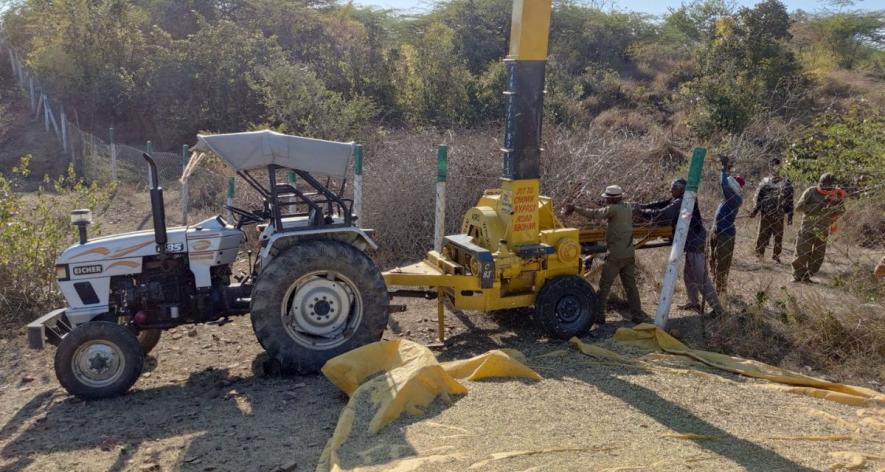
Workers making lantana chips (Photo - Sanavver Shafi, 101Reporters).
He further says that due to lantana overgrowth, access to forest produce has been gradually decreasing, and wild animals hiding in these bushes posed a risk to life. The villagers have to stay awake all night in their fields to monitor crops. “After the initiative, our problems have reduced to a great extent,” he attests.
Rampur Patha VFC member Maravi Singh (54) has been cultivating four acres of land, but fear of wild animals always forced him to guard the field day and night. The villagers also had to put up temporary fencing, which is no longer required.
Godan Tola VFC secretary Rahul Soni says they uprooted 171.86 metric tonnes of lantana last year, earning Rs 2.06 lakh in wages and Rs 85,930 as dividend. “We used the dividend to dig tube wells. Preparations are also being made to plant medicinal plants in the rainy season.”
Rampur Patha VFC provided 109 metric tonnes of lantana and earned Rs 1.85 lakh. Of this, Rs 1.31 lakh was spent on wages, while the committee received Rs 54,500. “About 712 people from 156 families in Rampur Patha came together to clear 77 hectares of forest land. Most of them are from the tribal community and do farming for a living,” says secretary Manoj Singh.
Kushram Mawasi (45) says local trees such as palash, jamun, raila, dhawa and karonda have started growing following the removal of lantana. Fodder for animals is available in the forest now, which has largely reduced crop damage by wild boar, deer and chital.
What next?
According to Pushpendra Gautam, supervisor, Gurukul Traders, most of the cement plants in Satna district started focusing on bioenergy as an alternative to coal last year, influenced by rising coal prices and Prime Minister Narendra Modi's self-reliant vision and vision of reducing carbon emissions. “This helped us make about Rs 20 lakh last year. As the machines provided by the department to crush lantana bushes were of very low capacity, it wasted a lot of our time. So, we bought a machine with higher capacity.”
However, he is not sure what is in store this year. “I do not think this time we will be as successful, because we are not seeing an increase in coal prices. Also, the forest department is not giving us any subsidy to buy machines bigger than those currently in use. If we use bigger machines, more work can be done in a shorter time. The wages are also high. The department should either reduce the wage rates or provide funds and subsidies for purchasing big machines,” Gautam notes.
Patel agrees that high coal prices turned the tide in their favour last time. “We are keeping an eye on coal prices... Using the dividend, we have made complete preparations for planting tree saplings during the rainy season. For this, one lakh saplings have been ordered from the forest nursery,” he says.
Sanavver Shafi is a Madhya Pradesh-based freelance journalist and a member of 101Reporters, a pan-India network of grassroots reporters.
Get the latest reports & analysis with people's perspective on Protests, movements & deep analytical videos, discussions of the current affairs in your Telegram app. Subscribe to NewsClick's Telegram channel & get Real-Time updates on stories, as they get published on our website.














